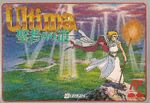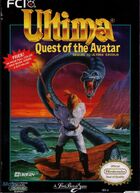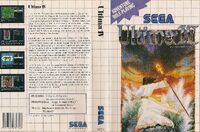Ultima IV is an interesting case, in that there actually exist two console versions of it. Nintendo wasn't happy that Origin had developed a port for Sega as well, and the threat of going to the courts delayed the Sega port. However, the threats proved empty, creating the interesting situation of comparing two console versions of the same game.
The two ports are very different, and both games were released in 1990.
The Nintendo Version[]

NES (Japan)box art

North American box art
The Nintendo Version for the NES is practically the same conversion idea as the NES-Port of Ultima III. The graphics are a little less colorful this time, but arguably more detailed and still very anime-like. The interface, like the last conversion, is completely removed from sight, apart from the moon phase-indicator.
The sound of the game was changed, with none of the music of the original remaining. The new music is not as repetitive as the port of Ultima III, but after some time still reportedly tempted players to mute their TV. Sound effects are the standard of the time.
The game has content changes, which include:
- Complete removal of the intro; meaning that the game jumps directly to the Virtue test. The story from the original introduction is told in the manual instead.
- The player can no longer choose the protagonist's gender at the beginning, with the character's class defining their gender instead. The mage, the druid and the shepherd are female classes, and all the other classes are male.
- Julia was gender-changed into a man, named Julius, for the reason described above. Furthermore, Mariah was pictured with a thick brown beard in the manual, despite still being female in the game itself.
- Gameplay was changed at the shrines and after finding the Codex of Ultimate Wisdom; in particular, the original endgame (the final Virtue test) is completely missing, replaced by an "autopilot" sequence where the Avatar reads the Codex then returns to Lord British.
- The game mechanics are less complex; food and wind direction are not factors, and enemies will never try to flee from battle.
- Conversations with NPCs are greatly simplified and streamlined.
- Much like a standard console RPG of the time, monsters are invisible on the map (i.e. encounters are random).
- The battle system was altered; instead of each party member acting individually, the player now enters commands for all party members before any of them are executed. This is, again, similar to standard console RPGs of the era. The party members always act first, in the order they are arranged, followed by all enemy units.
- There are slight differences in the layout of towns, castles and dungeons, enough to render standard maps and coordinates useless on the NES. A general familiarity with the standard Ultima IV is helpful, but not always.
- Spell casting was simplified. To cast a spell, the player must merely have the proper reagents on hand; i.e., mixing is not required first.
- The party size was reduced to four. One of the game's goals, that of showing leadership to all professions, is lost with this.
- You can still recruit all the available characters for your profession, but only three (plus yourself) can be in your adventuring party at any one time. The others wait for you in a special area of Lord British's castle, and only here can you rearrange your party.
See also[]
The Sega Version[]

Master System box art
The version for the Sega Master System is very different, since unlike the Nintendo port, it stays more faithful to the original. This already starts with the game box, which not only uses the original box art, but also includes a paper map of Britannia similar to the original cloth map. The History of Britannia and The Book of Mystic Wisdom, are likewise included, only reduced in size, and a detailed manual is also included. This is in stark contrast to the NES port, which only has a short instruction booklet.
The game itself is very much like the 16-bit versions on the computers, only with improved "western-style" graphics. The music is the same as the original, but improved in quality. The game also includes the complete introduction.
There are essentially three major changes in the game:
- The first is the dialogue system. The player can only ask things they know about (as in Ultima VII).
- The second concerns the dungeons. While it would have been possible to show them in 3D, all the dungeons are 2D from the top, which makes navigating in them easier, as they resemble dungeons from Ultima VI. In spite of this different point of view the dungeon maps remains the same as their computer counterparts.
- The third aspect is the combat system. Unlike the original version which only allowed to attack vertically and horizontally (just like in Ultima III), this port uses a combat system closer to Ultima V allowing the characters to attack diagonally as well.
Additionally, the game was mostly released for the Master System in Europe and Canada, and with only a few units reaching the USA. There were French, German, and English versions of the game released.
| Console Ports | |
|---|---|
| Games | Ultima III ☥ Ultima IV ☥ Ultima V ☥ Ultima VI ☥ Savage Empire ☥ Ultima VII |








